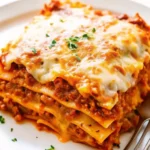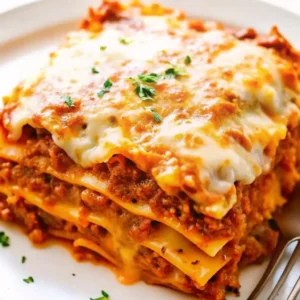Homemade Lasagna. Just the word conjures up images of warm, cheesy goodness, a comforting hug on a plate. This isn’t your grandma’s lasagna recipe (unless your grandma was a culinary genius!), but it’s a recipe born from a desire for simple, delicious food, made with fresh, high-quality ingredients. One of my favorite tips? Don’t be afraid to experiment with the herbs! A little extra basil or oregano can elevate this dish to the next level. Let’s get started!
Print
Homemade Lasagna Recipe
- Total Time: 1 hour 10 minutes
- Yield: 8-10
Description
This Homemade lasagna recipe is designed for ease and deliciousness. Here’s how to create a masterpiece
Ingredients
- Ground Beef: 1.5 lbs (lean ground turkey or beef is a healthier alternative)
- Onion: 1 large, chopped (small diced shallots offer a more delicate flavour)
- Garlic: 4 cloves, minced (use more for a stronger garlic punch!)
- Crushed Tomatoes: 28 oz can (San Marzano tomatoes provide a richer, sweeter flavor. Alternatively, you could use 28oz of passata.)
- Dried Oregano: 2 tsp (fresh oregano adds a brighter, more intense flavor)
- Dried Basil: 2 tsp (again, fresh basil elevates the flavor profile)
- Salt: 1.5 tsp (sea salt offers a more complex flavour)
- Black Pepper: 0.5 tsp (freshly ground black pepper is always best!)
- Ricotta Cheese: 15 oz container (part-skim ricotta reduces the fat content without sacrificing creaminess. Vegan ricotta alternatives are readily available.)
- Egg: 1 large (flax egg (1 tbsp flaxseed meal mixed with 3 tbsp water) is a great vegan substitute)
- Fresh Parsley: 2 tbsp, chopped
- Mozzarella Cheese: 2 cups, shredded (low-moisture mozzarella melts better and prevents a watery lasagna. Part-skim mozzarella reduces the fat content.)
- Parmesan Cheese: 0.5 cup, grated (vegan parmesan cheese is a good option for a plant-based lasagna)
- Lasagna Noodles: 9-12, oven-ready (no-boil lasagna noodles save time, but regular lasagna noodles will require pre-cooking according to package directions)
Instructions
- Preheat your oven to 375°F (190°C). This ensures even cooking and melting of your cheese.
- Brown the ground beef: In a large skillet, brown the ground beef over medium-high heat. Break it up with a spoon as it cooks. Drain any excess fat. This step is crucial for developing deep flavor. For a quicker browning, spread the beef evenly across the pan. Avoid overcrowding, which results in steaming instead of browning.
- Sauté the aromatics: Add the chopped onion and minced garlic to the skillet and cook until softened, about 5 minutes. This adds a base layer of flavor. Don’t burn the garlic – reduce the heat if necessary.
- Simmer the meat sauce: Stir in the crushed tomatoes, oregano, basil, salt, and pepper. Bring to a gentle simmer and cook for 15 minutes, stirring occasionally. Allowing the sauce to simmer develops a rich, complex flavor. A longer simmering time (up to 30 minutes) is recommended for maximum flavour depth. For a richer sauce, add 1 tbsp of tomato paste.
- Prepare the ricotta mixture: In a medium bowl, combine the ricotta cheese, egg, and parsley. Mix well. This creamy layer adds moisture and flavor to your lasagna. If using a vegan egg substitute, ensure it’s fully incorporated for a smooth, cohesive mixture.
- Assemble the lasagna: Spread a thin layer of meat sauce in the bottom of a 9×13 inch baking dish. Layer lasagna noodles over the sauce. Spread half of the ricotta cheese mixture over the noodles. Sprinkle 1/3 of the mozzarella and 1/4 of the parmesan cheese over the ricotta. Repeat these layers: meat sauce, noodles, ricotta mixture, mozzarella, and parmesan. Top with the remaining meat sauce, mozzarella, and parmesan cheeses.
- Bake the lasagna: Cover the baking dish with foil and bake for 30 minutes. Remove the foil and bake for an additional 15-20 minutes, or until the cheese is melted, bubbly, and golden brown. For crispier edges and a better cheese melt, broil the lasagna for the last 2-3 minutes (keeping a close eye to prevent burning).
- Rest and serve: Let the lasagna rest for 10-15 minutes before cutting and serving. This allows the lasagna to set, making it easier to serve neat slices. Use a large, sharp knife for clean cuts. Consider using cookie cutters to create fun shapes for kid-friendly portions.
Notes
These Nutritional Information (per serving, approximate) values are estimates and can vary based on the specific ingredients and portion sizes used. Consult a nutrition calculator for precise values.)
- Prep Time: 25 minutes
- Cook Time: 40 minutes
- Category: Meals and Sides
- Method: Easy
Nutrition
- Calories: 450-500 kcal
- Fat: 30
- Carbohydrates: 50
- Protein: 30
Keywords: Homemade Lasagna, Lasagna Recipe, Lasagna with Ricotta, Easy Lasagna
A Slice of History: The Story of Lasagna
Lasagna’s origins are debated, but its history is rich and delicious. Variations of layered pasta dishes existed in ancient Greece and Rome. The dish as we know it, however, likely developed in Naples during the Middle Ages, evolving with readily available ingredients. Over time, regional variations appeared throughout Italy, each reflecting local tastes and traditions. Emigration brought lasagna to the Americas, where it became a beloved comfort food, further evolving with the addition of new ingredients and techniques.

Lasagna: A Nutritional Powerhouse
This lasagna recipe isn’t just about taste; it offers nutritional benefits. Lean ground beef is a good source of protein, essential for building and repairing tissues. Tomatoes are packed with lycopene, a powerful antioxidant. Ricotta cheese provides calcium, important for bone health. And don’t forget the vegetables subtly added to the meat sauce! Additionally, the generous amount of vegetables adds fiber, contributing to healthy digestion. A serving of this lasagna provides a significant amount of protein and essential nutrients. However, it’s important to note that a single serving can be quite high in calories and fat, so portion control is key.
Pro Tips for Homemade Lasagna Perfection
- For a richer flavor, add a tablespoon of tomato paste to the meat sauce.
- Use a large serving spoon to get clean, appealing scoops.
- Letting the lasagna rest before cutting helps the layers set, making it easier to serve neat slices.
- For a vegetarian option, substitute the ground beef with lentils or mushrooms.
- Consider using a mandoline to thinly slice vegetables for an even better texture.
Lasagna FAQs
Here are some frequently asked questions about this lasagna recipe:
Can I make this lasagna ahead of time?
Yes! Assemble the lasagna completely and refrigerate it overnight. Add 10-15 minutes to the baking time.
Can I freeze this lasagna?
Yes, you can freeze the assembled lasagna before baking. Thaw it completely in the refrigerator before baking, adding about 15-20 minutes to the cooking time.
What are some other ways to use this meat sauce?
This meat sauce is versatile! Use it on pasta, as a pizza topping, or as a filling for stuffed peppers or zucchini boats.
What are the nutritional benefits of using San Marzano tomatoes?
San Marzano tomatoes are known for their rich, sweet flavor and lower acidity. They’re also a good source of lycopene.
Ready to Make Lasagna?
This easy homemade lasagna recipe is perfect for a cozy weeknight meal or a special occasion. Have you tried this recipe with a twist? Share your version in the comments!

